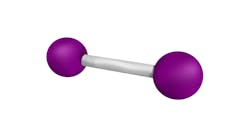Molecular iodine as a new frontline defense against COVID-19 in the dental office
In a recent study by the Institute for Antiviral Research at Utah State University, it was demonstrated that the COVID-19 virus can be completely inactivated with a 30-second exposure to a 100 ppm molecular iodine (I2) mouthrinse.1 This in vitro study opens the door for further research and the need to review past and current research about the efficacy of I2 as an antimicrobial therapeutic agent. I2 is the only species of iodine that is antimicrobial.2
It has been well documented that molecular iodine is one of the most effective of all antimicrobials available. Hospitals and medical facilities worldwide use povidone-iodine
(Betadine) as a standard of care in infection control, even though it contains very small amounts of I2. Betadine (PVP-1) has been in commercial use since 1955 and is on the World Health Organization’s list of essential medicines.3
PVP-1 contains 31,600 ppm of iodine compounds, but it is only I2 that is the biocidal species responsible for its antimicrobial activity. I2 occurs in trace quantities of 2–3 ppm, but even at these levels, it is considered the best at destroying bacteria, viruses, and fungi. All the other aspects of PVP-1 only contribute to its toxicity, staining, and unpleasant taste.4
For more than 50 years, PVP-1 has been used as an essential medicine in hospitals and health-care clinics as a scrub for surgeries as well as hand disinfection for surgical personnel. It has been an integral antiseptic as a wound disinfectant.
PVP-1 has also been shown to be highly effective in the treatment of periodontal disease. Jørgen Slots wrote that it is a valuable antiseptic in its treatment of periodontal disease and a variety of other oral infections. His research has shown that it kills all periodontal pathogens in vitro within 15–20 seconds. Slots also says that it exhibits a wide viricidal spectrum, covering both nonenveloped and enveloped viruses, including the periodontopathogenic cytomegalovirus.5
Fortunately, there is a new generation of recently patented iodine-based antiseptics that overcome the negative side effects of PVP-1. A new aqueous formulation with 100 times more I2 than contained in PVP-1 is now available, and the nonbiocidal content has been reduced from 31,600 ppm to a few hundred ppm. This new formulation increases its effectiveness, safety, and shelf life, while also reducing staining, toxicity, bad taste, and potential irritancy. It is now available in mouthrinses, concentrates, nasal sprays, and hand sanitizers offered by IoTech International.6 These new products have the potential to become a frontline defense against the COVID-19 pandemic.
Background
David Derry, MD, PhD, author of Iodine: The Forgotten Weapon Against Influenza Viruses, says that after 30 million people were killed by the 1918 Spanish flu pandemic, there was much research funded to discover which agents were effective against influenza viruses. Washing hands with a standard 70% alcohol is effective against most bacteria, but it was shown to have little effect against viruses. Masks used in 1918 showed barely detectable benefits in holding back the influenza viruses. More than 25 years of research has proven that iodine was the most effective agent. Aerosol iodine was found to kill viruses in sprayed mists. Oral preparations were also shown to be effective, along with handwashing using mild iodine solutions. Derry said research showed that iodine incorporated into masks, aerosols, and oral preparations could all help kill influenza viruses. His conclusions state that free iodine (molecular iodine) is the best way to combat an influenza outbreak.7
Nobel prize winner Sir Frank Macfarlane Burnet and Joyce D. Stone showed that when mice were exposed to lethal doses of influenza, a control group with iodine rubbed on their snouts survived while the unprotected mice died. They suggested that “it may be worth considering iodine vapor as a practical means of limiting indoor infection during an influenza epidemic.”8
Research has continued to show iodine to be effective against viruses. In 1943, Dunham and MacNeal demonstrated that vaccinia virus could be killed with a 3% tincture of iodine. In 1955, Louis Gershenfeld found that tincture of iodine was the most the effective antiseptic found to quickly destroy the poliovirus. He reported that he developed a mouthwash capable of killing the virus using concentrations of free iodine. These landmark studies and others demonstrate iodine’s efficacy as an antiviral.9
Recently, much research has been published on the effects PVP-1 has on the COVID-19 virus and its rapid inactivation upon exposure. Multiple studies have shown that povidone-iodine with its small amount of I2 has quick and effective antiviral qualities and is sufficient to be used as a proactive preventive therapy against COVID-19. It has many uses including hand and skin sanitizing, oral rinsing, throat spraying, gargling, and nasal spraying to inactivate the virus.10-12
Currently, the most common source of iodine disinfection is PVP-1, but there are limitations of use due to its staining, toxicity, and taste. This new generation of iodine products is now available and has eliminated these negative effects by isolating, stabilizing, and concentrating the bioactive I2. This has enormous implications in the management and treatment of many microbial-sourced diseases. Since I2 has been proven to completely inactivate the COVID-19 virus, it seems prudent that it be used in medical and dental environments.13
A preliminary protocol
Based upon the recent developments and research regarding I2’s effectiveness against all bacteria, viruses, and especially the COVID-19 virus, our dental office has been implementing its use in as many different delivery systems as we can to protect our patients and staff. We have developed a preliminary protocol for the use of I2.
We have every patient use IoTech’s 200 ppm hand sanitizer in the reception area. This has 100 times more I2 than conventional 7.5% PVP-1 that has been used as a surgical hand scrub for more than 50 years. We have a spray bottle at the front desk where we spray our patients’ hands and let them rub it in.
Once in the operatory, we have patients gargle and swish with IoTech’s RTU (ready to use) mouthwash, a 100 ppm I2 formula. Patients do this for 30 seconds, as the Utah State University study showed complete viral inactivation after a 30-second exposure.
We also add IoTech’s concentrated formula into our distilled water system, creating a 10% concentration that runs through our waterlines and handpieces. When we use an ultrasonic scaler, we use a 20% concentration in its self-contained water system. Studies have shown that I2 is extremely effective as a waterline disinfectant.14
Last but not least, we have air diffusers in the lobby and in each operatory that dispense I2 into the air to help kill any airborne viruses. This has been a suggested procedure many times in various research papers throughout the past few decades.15 Our diffusers are the standard ones used for diffusing scented oils for fragrance. We pour the unscented mouthwash formula into the diffuser and run it throughout the workday.
We have encouraged all of our patients and staff members to use I2 rinses as a daily at-home rinse. Dr. Gordon Christensen’s clinical evaluators highly recommended it as a preventive antimicrobial agent against periodontal and caries pathogens in Clinician’s Report. Now, COVID-19 gives us another reason to recommend I2.
IoTech has since come out with a saline/molecular iodine nasal spray that we suggest everyone use as research points to COVID-19 beginning in the mouth, throat, and nasopharyngeal areas. The nasal spray will disinfect areas unreachable by gargling. The 200 ppm hand sanitizer is extremely effective, and we highly recommend it. With these products, patients and staff can be proactive in preventing illness from the virus.16
Dentists now have an opportunity to help their patients and staff in the fight against the pandemic we are now facing. Not only can dentists help keep their patients healthy, but they can also raise their value as health-care providers in the community. Research has pointed us in the right direction with molecular iodine. We just need to implement it and spread the word that there is a safe and inexpensive pathway to prevention of COVID-19.
Author’s note: Dr. Trettenero has declared no financial relationship with IoTech International.
Editor’s note: This article first appeared in Through the Loupes newsletter, a publication of the Endeavor Business Media Dental Group. Read more articles at this link and subscribe here.
References
- Moskowitz H, Mendenhall M. Comparative analysis of antiviral efficacy of four different mouthwashes against severe acute respiratory syndrome Coronavirus 2: an in vitro study. Int J Experimental Dent Sci. 2020;9(1). doi:10.5005/jp-journals-10029-1209
- Kolsky RE, Moskowitz H, Kessler J. Stable compositions of uncomplexed iodine and methods of use. Infect Control. 2018;3(1). https://pubchem.ncbi.nlm.nih.gov/patent/US2018360048
- WHO model lists of essential medicines. World Health Organization. Updated June 2019. https://www.who.int/groups/expert-committee-on-selection-and-use-of-essential-medicines/essential-medicines-lists
- Hickey J, Panicucci R, Duan Y, et al. Control of the amount of free molecular iodine in iodine germicides. J Pharm Pharmacol. 1997;49(12):1195-1199. doi:10.1111/j.2042-7158.1997.tb06069.x
- Slots J. Low-cost periodontal therapy. Periodontol 2000. 2012;60(1):110-137. doi:10.1111/j.1600-0757.2011.00429.x
- IoTech International, Boca Raton, Florida: Stable compositions of uncomplexed iodine and methods of use. U.S. Pat. Appl. 20170208814A1
- Gershenfeld, L. Iodine as a virucidal agent. J Am Pharm Assoc (Sci ed.). 1955;44(3):177-182. doi:10.1002/jps.3030440315
- Burnet FM, Holden HF, Stone JD. Action of iodine vapour on influenza virus in droplet suspension. Aust J Sci. 1945;7:125-126.
- Derry D. Iodine: the forgotten weapon against influenza viruses. Thyroid Sci. 2009;4(8):R1-R5.
- Eggers M, Koburger-Janssen T, Eickmann M, Zorn J. In vitro bactericidal and virucidal efficiency of povidone-iodine gargle/mouthwash against respiratory and oral tract pathogens. Infect Dis Ther. 2018;7(2):249-259. doi:10.1007/s40121-018-0200-7
- Eggers M, Eickmann M, Kowalski K, Zorn J, Reimer K. Povidone-iodine hand wash and hand rub products demonstrated excellent in vitro virucidal efficacy against Ebola virus and modified vaccinia virus Ankara, the new European test virus for enveloped viruses. BMC Infect Dis. 2015;15:375. doi:10.1186/s12879-015-1111-9
- Kirk-Bayley J, Challacombe SJ, Sunkaraneni VS. The use of povidone iodine nasal spray and mouthwash during the current COVID-19 pandemic may protect healthcare workers and reduce cross infection. March 30, 2020. Updated May 19, 2020. doi:10.2139/ssrn.3563092
- Verheesen R, Traksel RAM. Iodine, a preventive and curative agent in the COVID-19 pandemic? Med Hypotheses. 2020;144:109860. doi:10.1016/j.mehy.2020.109860
- Puttaiah R, Seibert J, Spears R. Effects of iodine in microbial control of dental treatment water. J Contemp Dent Pract. 2011;12(3):143-151. doi:10.5005/jp-journals-10024-1025
- Stone JD, Burnet FM. The action of halogens on influenza virus with special reference to the action of iodine vapour on virus mists. Aust J Exp Biol Med Sci. 1945;23:205-212. doi:10.1038/icb.1945.32
- Khalil I, Barma P. Povidone iodine (PVP-1) mouth gargle/nasal spray may be the simplest and cost effective therapeutic antidote for COVID-19 frontier. Arch Community Med Public Health. 2020;6(2):138-141. doi:10.17352/2455-5479.000093







